 Democrat Karen Jacobs isn’t running any TV ads while campaigning for a state House seat in Texas. Even cheaper regional and local broadcast inventory is expensive because her squiggly district northeast of Dallas – known as one of the nation’s most gerrymandered – must hit multiple markets.
Democrat Karen Jacobs isn’t running any TV ads while campaigning for a state House seat in Texas. Even cheaper regional and local broadcast inventory is expensive because her squiggly district northeast of Dallas – known as one of the nation’s most gerrymandered – must hit multiple markets.
The district skews heavily Republican so any TV spending would be largely wasted on people voting for her competitor. Since local broadcast markets don’t overlap with Congressional districts, she’d also be spending on voters who couldn’t vote for her if they wanted to.
So Jacobs is focusing on digital and using DemocraticAds.com, an ad-buying tool primarily for down-ballot Democrats. “It allows me to get my message out to supporters and persuadable voters in a really cost-effective way,” she said.
Liberal ad tech provider DSPolitical developed DemocraticAds.com to provide self-serve targeting and media-buying to low spending campaigns. DSPolitical and other Democratic technology operatives hope these kinds of tools extend their party’s lead in data-driven campaigning and put new districts in play this year.
Earlier this summer, DemocraticAds.com integrated with NGP VAN, another liberal tech provider. NGP VAN, characterized as a “political CRM” by its president and CEO, is the database and dashboard for the Democratic National Committee and almost every Democratic campaign in the country.
Since 2014 NGP VAN has been building out its innovation platform, which serves as a developer toolkit for third-party vendor integrations. The platform has allowed new classes of political campaigns to activate its voter database, said NGP VAN president and CEO Stuart Trevelyan.
DemocraticAds.com takes three lists – a get-out-the-vote (GOTV) audience, a persuasion audience and likely voters – and lets candidates advertise to those lists in their districts, segmented by age, gender, voting history or previous campaign outreach.
The audience-targeting ability lets candidates atomize the “household,” an advertising unit that was once the most precise available.
“When we’re doing our field work it’s pretty easy to see that there are tons of split households,” Jacobs said. “We’ll see ‘Republican households’ but then lots of individual women or there’s a person in their early twenties who’s living there you want to pick out.”
Republicans have similar CRM-style data players, but haven’t yet replicated NGP VAN’s counterpart within its campaign ecosystem.
“Because RNC tools are pretty poor and unconsolidated, you see a lot of candidates splintering off to use other solutions,” Trevelyan said.
Some of the most prominent conservative technology firms, like the i360 data firm within the Koch brothers’ Freedom Partner super PAC, aren’t working with the presidential campaign this year. The conservative ecosystem generally is more fragmented and competitive where Democrats are cooperative.
Having a shared Democratic CRM “opens this technology up to so many campaigns and advocacy groups that aren’t working with an analytics shop or building their own models,” said DSPolitical CTO Mark Jablonowski.
It underscores how Democrats have differentiated from Republicans by fostering a system that is both idealistic and profitable, Jablonowski said.
“It makes it worth our while to take a $500 campaign because we don’t have to spend any time on the nuts and bolts of it,” he said.
Facebook has successfully pitched itself as a kind of agnostic, one-stop shop for efficient political targeting. But Facebook targeting is based on interest so it’s less precise than political data, Jacobs said. Facebook also relies on general engagement, which can be trollish.
“If you post something about gun control or some women’s issues you’re going to get flooded with responses, but let’s just say they’ll be unpositive,” Jacobs said, bursting into laughter.
Candidates can make sophisticated targeting lists within NGP VAN, but it’s historically been applied only through addressable channels, such as direct mail, canvassing and phone-banking.
“The innovation platform makes that kind of precision available in new channels we don’t own solutions for,” Trevelyan said.
For example, NGP VAN doesn’t offer its own tech in text messaging and mobile chat applications so it uses a third party called Hustle. The venture-backed, nonpartisan startup helps advocacy groups, event companies and political campaigns manage their mobile communications.
“Since organizing is our core competency, it’s really no surprise that most of our clients are on the liberal and Dem side,” said Hustle CEO Roddy Lindsay. “They’re just a lot more interested in this.”












